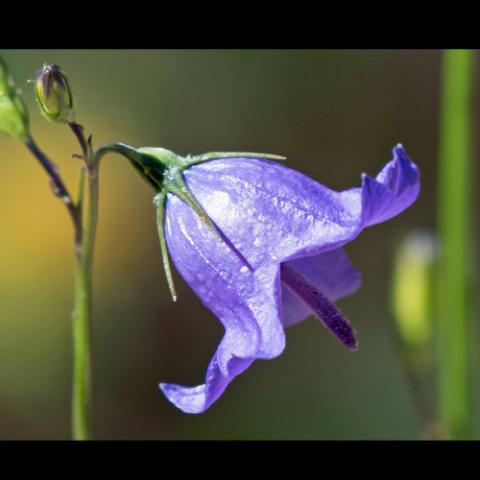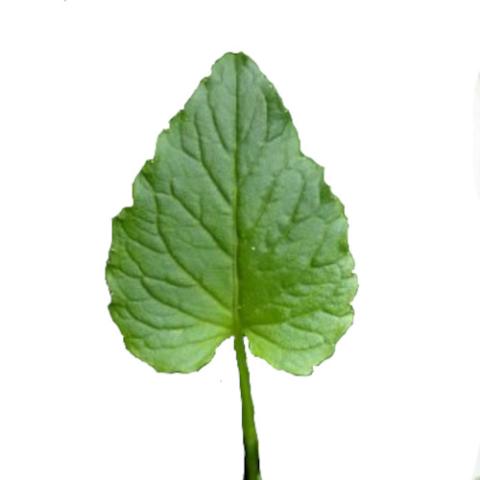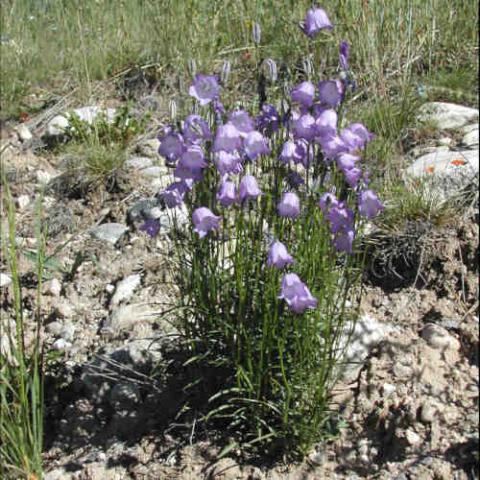NAME(S)
TAXONOMY
PLANTAE ID
THERAPEUTIC
United States
Issued:
Stamp:
Campanula rotundifolia
United States
Issued:
Stamp:
Campanula rotundifolia
United States
Issued:
Stamp:
Campanula rotundifolia
Genus species (Plantae): Campanula rotundifolia
Campanula rotundifolia, the common harebell, Scottish bluebell, or bluebell of Scotland, is a species of flowering plant in the bellflower family Campanulaceae. This herbaceous perennial is found throughout the temperate regions of the northern hemisphere. In Scotland, it is often known simply as bluebell. It is the floral emblem of Sweden where it is known as small bluebell. It produces its violet-blue, bell-shaped flowers in late summer and autumn.
The Latin specific epithet rotundifolia means "round leaved". However, not all leaves are round in shape. Middle stem-leaves are linear.
Description
Campanula rotundifolia is a slender, prostrate to erect herbaceous perennial, spreading by seed and rhizomes. The basal leaves are long-stalked, rounded to heart-shaped, usually slightly toothed, with prominent hydathodes, and often wither early. Leaves on the flowering stems are long and narrow and the upper ones are unstemmed. The inflorescence is a panicle or raceme, with 1 to many flowers borne on very slender pedicels. The flowers usually have five (occasionally 4, 6 or 7) pale to mid violet-blue petals fused together into a bell shape, about 12–30 mm (15⁄32–1+3⁄16 in) long and five long, pointed green sepals behind them. Plants with pale pink or white flowers may also occur. The petal lobes are triangular and curve outwards. The seeds are produced in a capsule about 3–4 mm (1⁄8–5⁄32 in) diameter and are released by pores at the base of the capsule. Seedlings are minute, but established plants can compete with tall grass. As with many other Campanula species, all parts of the plant exude white latex when injured or broken.
The flowering period is long and varies by location. In the British Isles, harebell flowers from July to November. In Missouri, it flowers from May to August; in Minnesota, from June to October. The flowers are pollinated by bees, but can self-pollinate.
Distribution and habitat
Campanula rotundifolia occurs from Spitzbergen, extending in mainland Europe from northernmost Scandinavia to the Pyrenees and the French Mediterranean coast. It also occurs on the southern coasts of Greenland, on Iceland and on southern Novaya Zemlya.
Some sources and authorities like the VASCAN and PLANTS do not currently separate out different species for North America. If using these sources it is widely distributed through North America including all of Canada and most of the United States.
It occurs as tetraploid or hexaploid populations in Britain and Ireland, but diploids occur widely in continental Europe. In Britain, the tetraploid population has an easterly distribution and the hexaploid population a westerly distribution, and very little mixing occurs at the range boundaries.
Harebells grow in dry, nutrient-poor grasslands and heaths. The plant often successfully colonizes cracks in walls or cliff faces and stable dunes.
Campanula rotundifolia is more inclined to occupy climates that have an average temperature below 0 °C in the cold months and above 10 °C in the summer.
In Iceland, research on Campanula rotundifolia has revealed that it is a host of at least three species of pathogenic fungi, Coleosporium tussilaginis, Puccinia campanulae and Sporonema campanulae (and the teleomorph Leptotrochila radians).
Reference: Wikipedia, pfaf.org.
Photos: dogofthedesert.net, illinoiswildflowers.info, alclanativeplants.com




